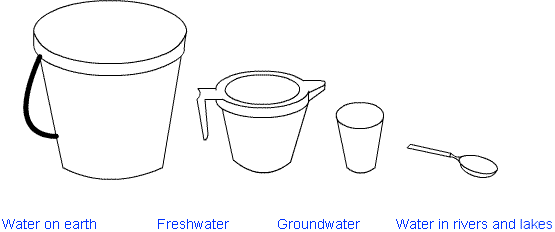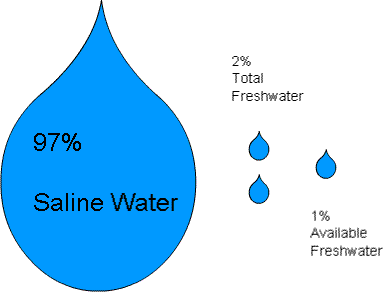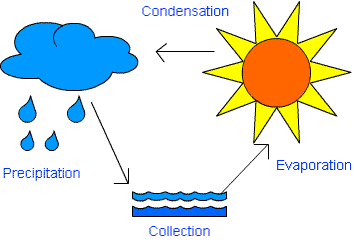Class 7 Geography Chapter 5 Notes - Water
Availability of Water on Earth:
About 71% of the earth’s surface is filled with water. But out of this, a very small amount is available for the human use.

If a bucketful of water shows the total water on the earth, then a mug of water shows the total freshwater available on the earth. Out of this, a glass of water shows the water which is available as groundwater. About one-fourth spoonful of water shows all the water available in lakes and rivers of the world.

Water Cycle: Water is available in all the three states of matter. Ice is the solid state, water is the liquid state and vapour is the gaseous state; in which water is available. The water on the earth keeps on changing in all the three states in a cycle. This is known as water cycle. The water cycle helps in keeping the amount of water on the earth as constant.
Following are the main steps of water cycle in nature:
Evaporation: Water from the surface of the earth keeps on evaporating and turns into vapour. The water vapour also comes from green plants through transpiration.
Condensation: The water vapour condenses to from clouds.
Precipitation: Water from the clouds falls on the land; in the form of precipitation. At higher altitudes, the condensed water from the clouds also falls in the form of ice.
Collection: The rainwater falls on the ground and runs off to the nearest water bodies. Some of this water seeps down the ground to recharge the groundwater. Rest of the water goes to the ocean via rivers.

Review Questions:
Q. How much of the earth’s surface is covered by water?
Answer: 71%
How much of the total water on the earth is available for human use?
Q. Answer: About 1%
Groundwater: Groundwater is the most important source of water for us. The water is stored under the ground; between layers of rocks. The upper limit of groundwater at a place is called the water table at that place. Water table is usually higher in the plains but is very low in the plateaus. This is the reason it is easier to install a hand-pump in the northern plains. On the other hand, it takes a heavy drilling machine to install a tube-well in the plateaus.
Depletion of water table: Due to growing human population, there is an increased demand for potable water. There is more need for drinking water and also for water for other purposes; like irrigation, economic activities and recreation. The supply of water either remains the same or has decreased, but demand has been continuously increasing. The mismatch in supply and demand is resulting in depletion of water table and most of the places are facing acute shortage of water.
Growing population means, there is more demand for foodgrains and hence farming is being done on a larger scale. More farming means more consumption of water for irrigation.
Growing population also means more construction of houses and pucca roads. This has created an impervious layer of concrete above the ground at most of the places. This has adversely affected the natural recharge of underground aquifers.
Forests have been cut to clear land for meeting the demand of a growing population. Trees make the rocks pervious to water and thus facilitate recharge of underground aquifers. Reduced forest cover has also hampered the natural recharge of underground aquifers.
Uneven Rainfall: India is a large country. Some parts of the country get excess rainfall, while some other parts get deficient rainfall. As a result, while some parts of the country are flooded during the rainy season, many other parts suffer from draught like conditions. Uneven rainfall also adds to the problem of water shortage.
Tackling of Water Shortage -
Rain Water Harvesting:
Collection of rainwater for future use is called rainwater harvesting. India has a long history of different rainwater harvesting structures; especially in rain deficient areas. For example; tankas and bawris had been in use in the northwestern part of India; especially in Rajasthan. Tanka is an underground tank to collect rainwater. Bawri is an open tank in which water used to be collected. Steps were made around the bawri so that one can easily access the water.
Rainwater harvesting can also be done in modern homes. The runoff rainwater from the rooftop should be collected in an underground reservoir. Such reservoirs are usually filled with sand and gravel to filter out impurities from water. The water can either be used directly or can be channelized to recharge the underground water.
Drip Irrigation: Drip irrigation is a method through which maximum number of plants can be irrigated with minimum use of water. For this, pipelines are laid throughout the rows of plants. Pipes are pierced at strategic points to release water in droplets. This helps in saving the water which is an important but scarce resource.
Review Questions:
Q. Which is the main source of water for us?
Answer: Groundwater
Q. Which is the main culprit of shortage of potable water?
Answer: Growing human population
Steps one can take to conserve water:
- Immediately repair any leaking tap in the household.
- Don’t let the tap remain open while brushing your teeth.
- Water left after washing or bathing can be used for mopping and for watering the plants.
- Avoid using a shower and use a bucketful of water instead.
|
62 videos|158 docs|34 tests
|
FAQs on Class 7 Geography Chapter 5 Notes - Water
| 1. What are the different sources of water? |  |
| 2. How can we conserve water in our daily life? |  |
| 3. Why is it important to drink clean water? |  |
| 4. What are the effects of water pollution? |  |
| 5. How can we prevent water pollution? |  |




















